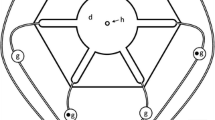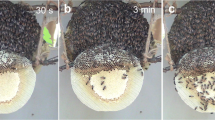Summary
Foraging differences between cross-fostered honeybee workers of European and Africanized races in South America are described. Africanized workers began foraging at earlier ages than European workers in colonies of their own races, but cross-fostered workers began foraging at the same age as workers in the colonies in which they were placed. Some differences in the mean time spent foraging per hour and the mean number of flights per hour were also found. The results suggest two major factors determining differences in division of labor between Africanized and European bees: 1) the colony characteristics by which foraging age is determined, and 2) the responses of individual workers to hive environment. A hypothesis to explain these results is presented based on higher levels of foraging stimuli in Africanized colonies as well as a higher stimulus threshold for Africanized workers.
Similar content being viewed by others
References
Boch R (1957) Rassenmäßige Unterschiede bei den Tänzen der Honigbiene (Apis mellifera L.). Z Vergl Physiol 40:289–320
Daly HV, Balling SS (1978) Identification of Africanized honeybees in the Western hemisphere by discriminant analysis. J Kans Entomol Soc 51:857–869
Fletcher DJC (1978) The African bee, Apis mellifera adansonii, in Africa. Annu Rev Entomol 23:151–171
Free JB (1965) The allocation of duties among worker honeybees. Symp Zool Soc (Lond) 14:39–59
Frisch K von (1967) The dance language and orientation of bees. Belknap Press, Cambridge, MA, p 566
Heyde K (1924) Die Entwicklung der psychischen Fähigkeiten bei Ameisen und ihr Verhalten bei abgeänderten biologischen Bedingungen. Biol Zentralbl 44:623–654
Lindauer M (1953) Division of labour in the honeybee colony. Bee World 34:63–73, 85–91
Michener CD (1974) The social behavior of the bees. Belknap Press, Cambridge, MA, p 404
Michener CD (1975) The Brazilian bee problem. Annu Rev Entomol 20:399–416
Nogueira-Neto P (1950) Notas bionomicas sobre meliponineos. IV. Colonies mistas e questoes relacionadas. Ref Entomol (Rio de Janeiro) 42:305–367
Nuñez JA (1979) Time spent on various components of foraging activity: comparison between European and Africanized honey-bees in Brasil. J Apic Res 18:110–115
Oster GF, Wilson EO (1978) Caste and ecology in the social insects. Princeton University Press, Princeton, NJ, p 352
Otis GW (1980) The swarming biology and population dynamics of the Africanized honeybees.PhD thesis, University of Kansas, Lawrence, KS
Poley W, Royce JR (1970) Genotype maternal stimulation, and factors of mouse emotionality. J Comp Physiol Psychol 71:246–250
Reading AJ (1966) Effects of maternal environment on the behavior of inbred mice. J Comp Physiol Psychol 62:437–440
Ressler RH (1963) Genotype-correlated parental influences in two strains of mice. J Comp Physiol Psychol 56:882–886
Ribbands CR (1952) Division of labour in the honeybee community. Proc R Soc Lond [Biol] 140:32–42
Rösch GA (1925) Untersuchungen über die Arbeitsteilung im Bienenstaat, I. Z Vergl Physiol 2:571–631
Rösch GA (1930) Untersuchungen über die Arbeitsteilung im Bienenstaat, II. Z Vergl Physiol 12:1–71
Ruttner F (1976) African races of honeybees. Proc XXVth Int Apic Congr, Grenoble. Bucharest, Apimondia, pp 325–344
Sekiguchi K, Sakagami SF (1966) Structure of foraging population and related problems in the honeybee, with considerations on the division of labor in bee colonies. Hokkaido Natl Agric Exp St 69:1–65
Steche W (1954) Gibt es „Dialekte” der Bienensprache? Dissertation, Naturwiss Fakultät, Universität München (in von Frisch 1967)
Taylor OR (1977) The past and possible future spread of the Africanized honeybess in the Americas. Bee World 58:19–30
Taylor OR, Levin MD (1978) Observations on Africanized honey-bees reported to South and Central American government agencies. Bull Entomol Soc Am 24:412–414
Wilson EO (1955) Division of labor in a nest of the slave-making ant Formica wheeleri Creighton. Psyche 62:130–133
Winston ML (1979a) The potential impact of the Africanized honeybee on apiculture in Mexico and Central America. Am Bee J 119:584–586
Winston ML (1979b) Intra-colony demongraphy and reproductive rate of the Africanized honeybee in South America. Behav Ecol Sociobiol 4:279–292
Winston ML, Katz SJ (1981) Longevity of cross-fostered honeybee workers of European and Africanized races. Can J Zool 59:1571–1575
Winston ML, Dropkin J, Taylor OR (1981) Demography and life history characteristics of two honeybee races (Apis mellifera). Oecologia (Berl) 48:407–413
Author information
Authors and Affiliations
Rights and permissions
About this article
Cite this article
Winston, M.L., Katz, S.J. Foraging differences between cross-fostered honeybee workers (Apis mellifera) of European and Africanized races. Behav Ecol Sociobiol 10, 125–129 (1982). https://doi.org/10.1007/BF00300172
Received:
Accepted:
Issue Date:
DOI: https://doi.org/10.1007/BF00300172



